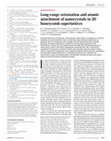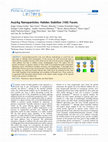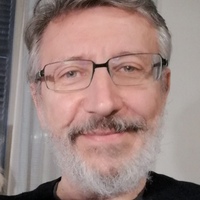Papers by Thomas Altantzis
Advanced Materials, 2014
ABSTRACT The simple combination of a weak magnetic field with turbulent flow during material synt... more ABSTRACT The simple combination of a weak magnetic field with turbulent flow during material synthesis results in significantly improved crystalline order and morphology, obtained by mounting a permanent magnet on a tube system. This newly discovered magneto-hydrodynamic effect is demonstrated by C. E. A. Kirschhock, E. Breynaert and co-workers on page 5173 for three technologically relevant materials: COK-16 metal organic frameworks, manganese oxide nanotubes, and vanadium oxide nanoscrolls.
Chemistry of Materials, 2016
Ultramicroscopy, 2016
It is very challenging to measure the chemical composition of hetero nanostructures in a reliable... more It is very challenging to measure the chemical composition of hetero nanostructures in a reliable and quantitative manner. Here, we propose a novel and straightforward approach that can be used to quantify energy dispersive X-ray spectra acquired in a transmission electron microscope. Our method is based on a combination of electron tomography and the so-called ζ-factor technique. We will demonstrate the reliability of our approach as well as its applicability by investigating Au-Ag and Au-Pt hetero nanostructures. Given its simplicity, we expect that the method could become a new standard in the field of chemical characterization using electron microscopy.
Particle & Particle Systems Characterization, 2016

Journal of the American Chemical Society, Jan 16, 2016
The concept of template-confined chemical reactions allows the synthesis of complex molecules tha... more The concept of template-confined chemical reactions allows the synthesis of complex molecules that would hardly be producible through conventional method. This idea was developed to produce high quality nanocrystals more than 20 years ago. However, template-mediated assembly of colloidal nanocrystals is still at an elementary level, not only because of the limited templates suitable for colloidal assemblies, but also because of the poor control over the assembly of nanocrystals within a confined space. Here, we report the design of a new system called "supracrystalline colloidal eggs" formed by controlled assembly of nanocrystals into complex colloidal supracrystals through superlattice-matched epitaxial overgrowth along the existing colloidosomes. Then, with this concept, we extend the supracrystalline growth to lattice-mismatched binary nanocrystal superlattices, in order to reach anisotropic superlattice growths, yielding freestanding binary nanocrystal supracrystals th...

ACS applied materials & interfaces, Jan 29, 2016
Studying protein interactions is of vital importance both to fundamental biology research and to ... more Studying protein interactions is of vital importance both to fundamental biology research and to medical applications. Here, we report on the experimental proof of a universally applicable label-free homogeneous platform for rapid protein analysis. It is based on optically detecting changes in the rotational dynamics of magnetically agitated core-shell nanorods upon their specific interaction with proteins. By adjusting the excitation frequency, we are able to optimize the measurement signal for each analyte protein size. In addition, due to the locking of the optical signal to the magnetic excitation frequency, background signals are suppressed, thus allowing exclusive studies of processes at the nanoprobe surface only. We study target proteins (soluble domain of the human epidermal growth factor receptor 2 - sHER2) specifically binding to antibodies (trastuzumab) immobilized on the surface of our nanoprobes and demonstrate direct deduction of their respective sizes. Additionally, ...

Nanoscale, 2015
Nanoparticle assemblies can be investigated in 3 dimensions using electron tomography. However, i... more Nanoparticle assemblies can be investigated in 3 dimensions using electron tomography. However, it is not straightforward to obtain quantitative information such as the number of particles or their relative position. This becomes particularly difficult when the number of particles increases. We propose a novel approach in which prior information on the shape of the individual particles is exploited. It improves the quality of the reconstruction of these complex assemblies significantly. Moreover, this quantitative Sparse Sphere Reconstruction approach yields directly the number of particles and their position as an output of the reconstruction technique, enabling a detailed 3D analysis of assemblies with as many as 10 000 particles. The approach can also be used to reconstruct objects based on a very limited number of projections, which opens up possibilities to investigate beam sensitive assemblies where previous reconstructions with the available electron tomography techniques failed.

Nano Letters, 2015
Directed assembly of gold nanorods through the use of dithiolated molecular linkers is one of the... more Directed assembly of gold nanorods through the use of dithiolated molecular linkers is one of the most efficient methodologies for the morphologically controlled tip-to-tip assembly of this type of anisotropic nanocrystals. In a direct analogy to molecular polymerization synthesis, this process is, however, characterized by difficulties in chain-growth control over nanoparticle oligomers. In particular, it is nearly impossible to favour the formation of one type of oligomer, making the methodology hard to use for actual applications in nanoplasmonics. We propose here a light-controlled synthetic procedure that allows obtaining selected plasmonic oligomers, in high yield and with reaction times in the scale of minutes, by irradiation with low fluence near-infrared (NIR) femtosecond laser pulses. Selective inhibition of the formation of gold nanorod n-mers (trimers) with a longitudinal localized surface plasmon in resonance with a 800 nm Ti:sapphire laser, allowed efficient trapping of the (n-1)-mers (dimers) by hot spot mediated photothermal decomposition of the interparticle molecular linkers. Laser irradiation at higher energies produced near-field enhancement at the interparticle gaps, which is large enough to melt gold nanorod tips, offering a new pathway toward tip-to-tip welding of gold nanorod oligomers with a plasmonic response at the NIR. Thorough optical and electron microscopy characterization indicates that plasmonic oligomers can be selectively trapped and welded, which has been analyzed in terms of a model that predicts with reasonable accuracy the relative concentrations of the main plasmonic species.
Ultramicroscopy, 2015
We present the ASTRA Toolbox as an open platform for 3D image reconstruction in tomography. Most ... more We present the ASTRA Toolbox as an open platform for 3D image reconstruction in tomography. Most of the software tools that are currently used in electron tomography offer limited flexibility with respect to the geometrical parameters of the acquisition model and the algorithms used for reconstruction. The ASTRA Toolbox provides an extensive set of fast and flexible building blocks that can be used to develop advanced reconstruction algorithms, effectively removing these limitations. We demonstrate this flexibility, the resulting reconstruction quality, and the computational efficiency of this toolbox by a series of experiments, based on experimental dual-axis tilt series.

Science (New York, N.Y.), Jan 20, 2014
Oriented attachment of synthetic semiconductor nanocrystals is emerging as a route for obtaining ... more Oriented attachment of synthetic semiconductor nanocrystals is emerging as a route for obtaining new semiconductors that can have Dirac-type electronic bands such as graphene, but also strong spin-orbit coupling. The two-dimensional (2D) assembly geometry will require both atomic coherence and long-range periodicity of the superlattices. We show how the interfacial self-assembly and oriented attachment of nanocrystals results in 2D metal chalcogenide semiconductors with a honeycomb superlattice. We present an extensive atomic and nanoscale characterization of these systems using direct imaging and wave scattering methods. The honeycomb superlattices are atomically coherent and have an octahedral symmetry that is buckled; the nanocrystals occupy two parallel planes. Considerable necking and large-scale atomic motion occurred during the attachment process.

Powder Technology, 2012
ABSTRACT In this work, nanocrystalline Mg2Si material was fabricated via wet ball milling process... more ABSTRACT In this work, nanocrystalline Mg2Si material was fabricated via wet ball milling process using n-hexane as process control agent. Milling parameters, with emphasis on milling time and ball size, and conditions were studied in order to understand the process and investigate its effect on the structural features of the material. Crystallite size evolution during ball milling was followed by powder X-ray diffraction measurements as well as Transmission Electron Microscopy studies. Scanning Electron Microscopy images showed the agglomeration of the crystallites and the formation of particles with minimum mean size of ~ 1.6 μm. The simultaneous formation of MgO in the material is shown through powder X-ray diffraction and electron diffraction TEM studies. The broadened PXRD peaks were analyzed and crystalline size was estimated based on Scherrer equation. The crystallite size distributions were studied based on the analysis of Dark Field images and were well described based on a Log-Normal equation. The effect of the size of the balls during milling was clear and leads to bi-modal and uni-modal distributions when large and small balls were used, respectively. IR reflectivity spectra showed blueshifting and broadening of the modes on increasing milling time that may also be assigned to decreasing grain size and particle shape effects.

Nanoscale, Jan 7, 2013
Herein we describe the synthesis of water-soluble platinum nanodendrites in dimethylformamide (DM... more Herein we describe the synthesis of water-soluble platinum nanodendrites in dimethylformamide (DMF), in the presence of polyethyleneimine (PEI) as a stabilizing agent. The average size of the dendrites is in the range of 20-25 nm while their porosity can be tuned by modifying the concentration of the metal precursor. Electron tomography revealed different crystalline orientations of nanocrystallites in the nanodendrites and allowed a better understanding of their peculiar branching and porosity. The high surface area of the dendrites (up to 22 m(2) g(-1)) was confirmed by BET measurements, while X-ray diffraction confirmed the abundance of high-index facets in the face-centered-cubic crystal structure of Pt. The prepared nanodendrites exhibit excellent performance in the electrocatalytic oxidation of ethanol in alkaline solution. Sensing, selectivity, cycleability and great tolerance toward poisoning were demonstrated by cyclic voltammetry measurements.
Thin Solid Films, 2012
La 5 Ca 9 Cu 24 O 41 3-ω method Pulsed laser deposition
Particle & Particle Systems Characterization, 2013

Nanoscale, 2013
Herein we describe the synthesis of water-soluble platinum nanodendrites in dimethylformamide (DM... more Herein we describe the synthesis of water-soluble platinum nanodendrites in dimethylformamide (DMF), in the presence of polyethyleneimine (PEI) as a stabilizing agent. The average size of the dendrites is in the range of 20-25 nm while their porosity can be tuned by modifying the concentration of the metal precursor. Electron tomography revealed different crystalline orientations of nanocrystallites in the nanodendrites and allowed a better understanding of their peculiar branching and porosity. The high surface area of the dendrites (up to 22 m(2) g(-1)) was confirmed by BET measurements, while X-ray diffraction confirmed the abundance of high-index facets in the face-centered-cubic crystal structure of Pt. The prepared nanodendrites exhibit excellent performance in the electrocatalytic oxidation of ethanol in alkaline solution. Sensing, selectivity, cycleability and great tolerance toward poisoning were demonstrated by cyclic voltammetry measurements.

The Journal of Physical Chemistry Letters, 2013
Seed-mediated growth is the most efficient methodology to control the size and shape of colloidal... more Seed-mediated growth is the most efficient methodology to control the size and shape of colloidal metal nanoparticles. In this process, the final nanocrystal shape is defined by the crystalline structure of the initial seed as well as by the presence of ligands and other additives that help to stabilize certain crystallographic facets. We analyze here the growth mechanism in aqueous solution of silver shells on presynthesized gold nanoparticles displaying various well-defined crystalline structures and morphologies. A thorough threedimensional electron microscopy characterization of the morphology and internal structure of the resulting core−shell nanocrystals indicates that {100} facets are preferred for the outer silver shell, regardless of the morphology and crystallinity of the gold cores. These results are in agreement with theoretical analysis based on the relative surface energies of the exposed facets in the presence of halide ions.










Uploads
Papers by Thomas Altantzis